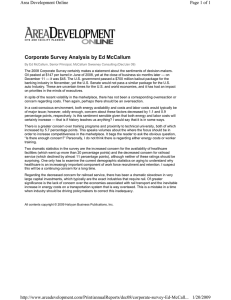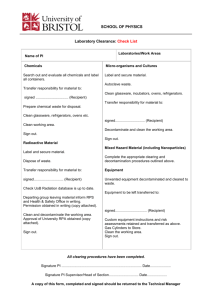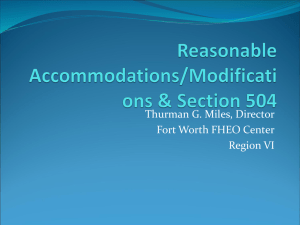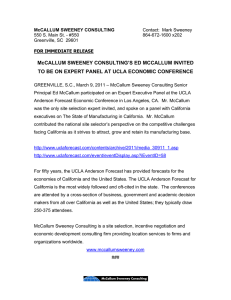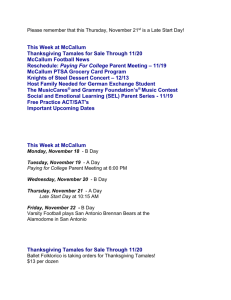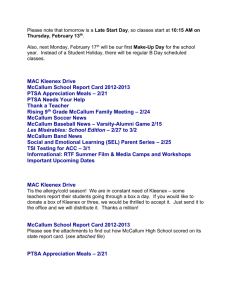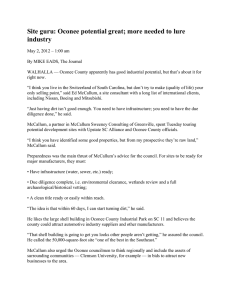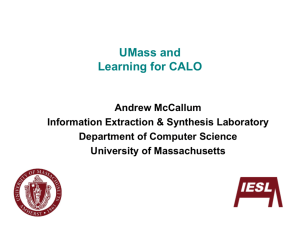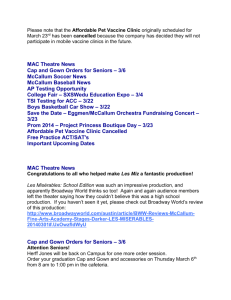lecture
advertisement
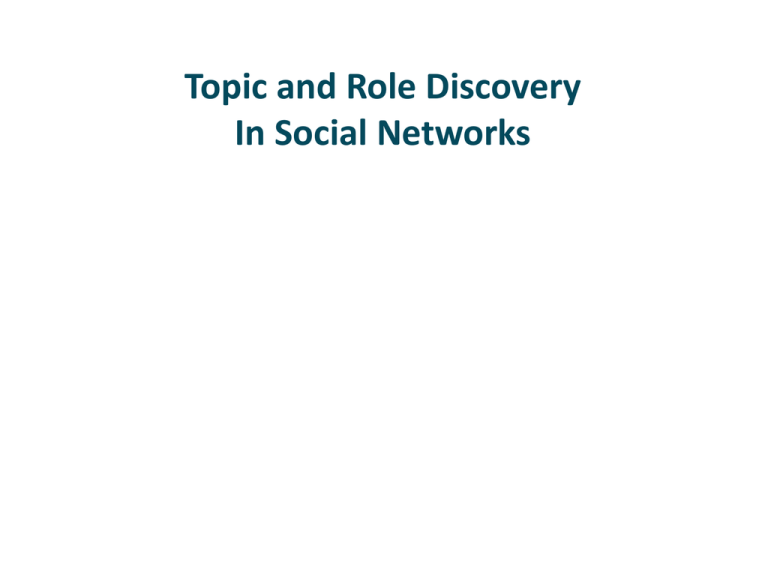
Topic and Role Discovery
In Social Networks
Review of Topic Model
Review of Joint/Conditional Distributions
What do the following tell us:
P(Zi)
P(Zi | {W,D})
P(Zi , Zj | {W,D})
Extending The Topic Model
Topic Model spawned gobs of research
e.g., visual topic models
e.g., Joe Cooper’s work on pose and motion
modeling
Bissacco, Yang, Soatto, NIPS 2006
Today’s Class
Extending topic modeling to social network analysis
Show how research in a field progresses
Show how Bayesian nets can be creatively tailored
to tackle specific domains
Convince you that you have the background to read
probabilistic modeling papers in machine learning
Social Network Analysis
Graph in which nodes are individuals or organizations
Links represent relationships (interaction,
communication)
Graph properties
connectedness / distance to other nodes
natural clusters / bridge points
Examples
interactions among blogs on a topic
communities of interest among faculty
spread of infections within hospital
9/11 Hijacker Analysis
Indadequacy of Current Techniques
Social network interaction
Capture a single type of relationship
No attempt to capture the linguistic content of the
interactions
Statistical language models (e.g., topic model)
Don't capture directed interactions and relationships
between individuals
Latent Dirichlet Allocation
(Blei, Ng, & Jordan, 2003)
Author Model (McCallum, 1999)
Documents: research articles
ad: set of authors associated with document
z: a single author sampled from set
(each author discusses a single topic)
Author-Topic Model (Rosen-Zvi,
Griffiths, Steyvers, & Smyth, 2004)
Documents: research articles
Each author's interests are modeled by a mixture of
topics
x: one author
z: one topic
Can Author-Topic Model Be Applied To Email?
Email: sender, recipient, message body
Could handle email if
Ignored recipients
But discards important information about
connections between people
Each sender and recipient were considered
an author
But what about asymmetry of relationship?
Author-Recipient-Topic (ART) Model
(McCallum, Corrado-Emmanuel, & Wang, 2005)
Email: sender, recipient, message body
Generative model for a word
pick a particular recipient from rd
chose a topic from multinomial
specific to author-recipient pair
sample word from topic-specific
multinomial
Review/Quiz
What is a document?
How many values of θ are there?
Can data set be partitioned into subsets
of {author, recipient} pairs and each
subset is analyzed separately?
What is α?
What is β?
What is form of P(w|z,φ1, φ2, φ3,… φT)?
Author-Recipient-Topic (ART) Model
joint distribution
marginalizing over topics
Methodology
Exact inference is not possible
Gibbs Sampling (Griffiths & Steyvers, Rosen-Zvi et al.)
variational methods (Blei et al.)
expectation propagation (Griffiths & Steyvers, Minka &
Lafferty)
McCallum uses Gibbs sampling of latent variables
latent variables: topics (z), recipients (x)
basic result:
Derivation
Want to obtain posterior over z and x given corpus
nijt: # assignments of topic t to author i with recipient j
mtv : # occurrences of (vocabulary) word v to topic t
is conjugate prior of
is conjugate prior of
Data Sets
Enron
23,488 emails
147 users
50 topics
McCallum email
23,488 emails
825 authors, sent or received by McCallum
50 topics
Hyperpriors
α = 50/T
β = .1
Enron Data
Human-generated label
three author/recipient pairs
with highest probability
for discussing topic
Hain: in house lawyer
Enron Data
Beck: COO
Dasovich: Govt Relations
Steffes: VP Govt. Affairs
McCallum's Email
Social Network Analysis
Stochastic Equivalence Hypothesis
Nodes that have similar connectivity must have similar roles
e.g., email network: probability that one node communicates
with other nodes
How similar are two probability distributions?
Jensen-Shannon divergence = measure of dissimilarity
DKL
1/JSDivergence = measure of similarity
For ART, use recipient-marginalized topic distribution
Predicting Role Equivalence
Block structuring JS divergence matrix
SNA
ART
AT
#9: Geaccone: executive assistant
#8: McCarty: VP
Similarity Analysis With McCallum Email
Role-Author-Recipient Topic (RART) Model
Person can have multiple roles
e.g., student, employee, spouse
Topic depends jointly on roles of author and recipient
